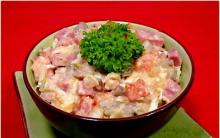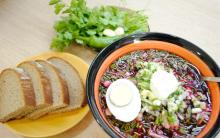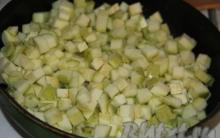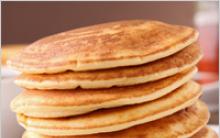Actually, since childhood, I have become accustomed to the fact that the word “balyk” refers to fish, and Wikipedia says the same thing. Balyk is the back of large fish of valuable species salted and air-dried in a certain way. But, nevertheless, in Russia this word is used not only for products made from fish, but also from meat. Or turkey, as in this case. Since I came across this recipe with exactly this name, I see no reason to change it, let it remain as it is. I only changed it a little because many people wrote in the comments that the finished product was too salty. At the same time, let’s check the correctness of my assumptions about its change.
Ingredients:
Turkey fillet - 1 kg.
Salt - 250 gr.
Cognac (whisky, vodka) - 50 ml.
Red pepper - 1/2 tsp.
Black pepper - 1/2 tsp.
Bay leaf - 6-8 pcs.
Turmeric - 1/2 tsp.
Paprika - 1/2 tsp.
Curry - 1/2 tsp.
Dried garlic - 1/2 tsp.
Oregano - 1/2 tsp.
I cook from 500 gr. Turkey, therefore, I use less spices.
So, rinse the turkey fillet in water and dry it with a towel or napkin.
If you noticed, the breast is always thicker on one side. And we need the piece of meat to be even, so that everything is salted evenly.
To do this, you need to cut the thick edge a little and unfold it like a book.
Now that's what we need.
Now we take out the salt and spices. (In the original recipe, everything was mixed at once and the turkey was marinated in this mixture. But! In the future, this piece of turkey will need to be rinsed under running cold water. And all the spices, naturally, will be washed off. What’s the point? I already did something similar back then drew attention to this point. Therefore, for starters, let's take only salt, and a little pepper, and a little turmeric, for color).
Stir and add cognac (whisky, vodka) to the mixture.
Mix. The result will be a mixture like wet sand.
Coat the fillet on all sides, add bay leaf.
Cover with film or a lid and put in the refrigerator for 12-14 hours. (In the original recipe for 24 hours, but, as I already wrote, people complained that the meat turned out to be very salty, so we reduce the salting time.).
After the specified time has passed, remove the fillet from the refrigerator. The meat gave off plenty of juice. Drain all this, and rinse the piece of meat itself from salt under running cold water. By this time, the meat itself had already become a little hard, dense, not the same as it was at the very beginning.
Soak in water for one and a half hours. (True, I was distracted by other matters and it took me about five hours to soak. That’s what happened).
Remove the meat from the water and dry with a towel or napkin.
Now mix all the spices and rub the meat with them on all sides.
Wrap the fillet in cheesecloth.
And hang in the refrigerator for 2 days (according to the original recipe). Just hang it up, not put it down. Place a plate underneath, because... Meat juice may still be released.
After 2 days I felt the balyk and it seemed to me that this time was not enough. I left it to dry.
4 days have passed. We take it out and untie it.
Turkey jerky is a tasty and healthy delicacy. Its calorie content per 100 g is only 303 kcal. Moreover, 53% of nutrients come from protein. Therefore, dried turkey is useful for athletes, people engaged in physical labor and mental activity. A bag of turkey jerky is convenient to take with you and use as a snack at work or school. Jerky is a great addition to beer; it’s a great help when camping or traveling. It is not afraid of sudden changes in temperature and humidity. Meat snacks in camping conditions retain their freshness for more than two weeks. You can buy the delicacy at an attractive price in the Snacker online store.
Features of turkey meat
Turkey meat is considered dietary. It is easily absorbed by the body and has a low cholesterol content. Along with animal protein, many useful microelements enter the body: potassium, calcium, iron, phosphorus and vitamins A and E. Turkey meat contains a lot of sodium salts. Sodium is involved in the process of replenishment and renewal of blood plasma. And when cooking, salt consumption is reduced to a minimum. Turkey has a beneficial effect on the process of calcium absorption in the human body. It is indicated for use for the prevention of osteochondrosis and other joint diseases.
To prepare turkey jerky snacks, we use only high-quality raw materials from trusted suppliers. Vacuum packaging prevents the penetration and proliferation of pathogenic microorganisms. Therefore, our products bring not only taste pleasure, but also benefits.
How to order?
When purchasing over 3,000 rubles, we will deliver your order for free!
You can also become a participant in promotions and receive pleasant discounts and bonuses.
Today is the long-awaited Friday and I am revealing the promised bombshell of intrigue.I want to warn you right away - the meat is not subjected to any heat treatment to such an extent as to kill any possible microorganisms in it. Therefore, if you are afraid of salmonella, worms, bovine tapeworm and other “friends”, it is better to just read the information below and not try any experiments with your health.
Meat should be purchased from trusted suppliers (I would not risk using “my own” meat and meat from markets for this recipe - there is no guarantee of complete absence of life, I prefer the butcher shop closest to me, where I personally know all the sellers and they can honestly answer how many hours ago this lamb shit on the lawn).Before the actual drying, a salting process will take place - for this you MUST use glass or ceramic dishes to prevent oxidation of the food (this is actually harmful to health and greatly affects the taste for the worse).
You need to use SEA salt, no coarse rock salt - it will be too salty. Sea salt is less soluble and has the ability to penetrate into foods exactly as much as needed.
I will show you all my results at once, and you can choose the one that you like the most.
At first I made friends with a group of birds. Duck breasts, for your information, are sold in some supermarkets - frozen and for a lot of money. Someone experimented with these, but I didn’t dare - fresh meat cannot be compared with frozen!
For "experiments" I had chicken and turkey fillet- turkey meat is denser and red; chicken - soft and tender, slightly yellow.
For 3 chicken breasts I needed 2 turkey breasts (the total weight of meat is just over a kilogram):
2-3 tablespoons black pepper (coarsely chopped)
2-3 tablespoons thyme and rosemary mixture
0.5 cups cognac
0.5 glasses of port wineMix all ingredients in a bowl. The liquid should evenly moisten the salt and make it loose. Of course, it is better to take good alcohol, and if finding cognac is generally not a problem, then it is categorically not recommended to take the publicly available port wine “777”! Search, you will find a decent and tasty one.
We take a ceramic or glass form, put half of the salt mixture on the bottom, place poultry fillets on top of it, loosely together, and cover with the remaining mixture, so that the meat does not stick out anywhere.
If liquid detachment occurs (as in the photo), it’s not scary, after a while everything will return to normal.
Set aside.Now for the pork (let’s do this - everything here is at your own peril and risk! I’m not afraid of dry-cured pork).
For a kilogram of pork tenderloin you need:
1 kilogram of coarse sea salt
8 tablespoons black pepper (coarsely chopped)
2 tablespoons red pepper (crushed) or finely chopped a couple of fresh chili peppers (without seeds)
2 tablespoons cognac
2 tablespoons dried sageThe pork tenderloin must be cleaned of all veins, membranes and other fibers.
Mix pickling ingredients. Please note that for chicken and turkey we used a full glass of liquid, but for pork we only need 2 tablespoons of cognac.We also put half of the mixture in the mold, a piece of pork on it, and sprinkle the remaining salt on top.
Set aside.That's it, just salt and coarsely ground black pepper, no aromatic herbs or cognac.
Well, everything is standard: We clean the meat from the films, put half the mixture into the mold, meat on top, half the mixture on top.All preparatory dances with a tambourine are finished! Then everything is absolutely the same for any type of meat.
Cover containers with meat covered with salt tightly with cling film and place in the refrigerator for 12 hours.After 12 hours, we remove the pieces of meat from the salt burial (the flavored salt can be used several more times) and rinse thoroughly under cold running water to wash away all the adhering crystals and spices. Dry very thoroughly with a napkin - the meat should not be wet.
Here are some closer photos for comparison:
Chicken and turkey- the chicken became more yellow, and the turkey turned pink. But the most important thing is that the elasticity inherent in fresh meat has disappeared, the fibers seem to have hardened, you see, even from the edge of the plate the ends of the fillet do not hang, but cheerfully stick out parallel to the table))Pork, on the contrary, has slightly lost color, but in general has not changed much
But the bright red beef changed its color to a juicy burgundy and became somehow grainy, like dry-cured sausage.
Wrap the pieces of meat in a thin breathable cloth, gauze or a paper napkin that is not very thick, but not sticky, and place it in the refrigerator for another 12 hours.
It’s great if the refrigerator is equipped with a No Frost system - the refrigerator has special fans that ensure air circulation inside the chamber. Unprotected by bags, films and original packaging, the products in such refrigerators seem to dry out (because of this, some consumers criticize such refrigerators and honestly defrost their usual refrigerators with a drip system). But this “drying” is to our advantage this time! That’s why the fabric/napkin with which we wrapped the pieces of meat must be breathable - meat salted for 12 hours will now dry out for the same amount of time (dry out slowly, releasing moisture).
In general, it would be ideal to hang a piece of meat in the refrigerator compartment so that there is air access from all sides, but you can simply place your valuable packages on the refrigerator shelf:After this time, we unfold and admire:
Chicken and turkey You can eat now! Plane into thin translucent slices and enjoy, but pork and beef we have to dry for another whole week)) It will also be completely non-lethal for the bird to dry for some more time, if you wish, but it is worth considering that every day this already hardened former tender meat will harden even more.
Now I will show control sections after 12 hours of drying:
I want to warn you right away - the meat is not subjected to any heat treatment to the point of killing any possible microorganisms in it. Therefore, if you are afraid of salmonella, worms, bovine tapeworm and other “friends”, it is better to just read the information below and not try any experiments with your health.
Meat should be purchased from trusted suppliers (I would not risk using “my own” meat and meat from markets for this recipe - there is no guarantee in the complete absence of life, I prefer the butcher shop closest to me, where I personally know all the sellers and they can honestly answer how many hours ago this lamb shit on the lawn).
Before the actual drying, a salting process will take place - for this you MUST use glass or ceramic dishes to prevent oxidation of the food (this is actually harmful to health and greatly affects the taste for the worse).
You need to use SEA salt, no coarse rock salt - it will be too salty. Sea salt is less soluble and has the ability to penetrate into foods exactly as much as needed.
I will show you all my results at once, and you can choose the one that you like the most.
At first I made friends with a group of birds. Duck breasts, for your information, are sold in some supermarkets - frozen and for a lot of money. Someone experimented with these, but I didn’t dare - fresh meat cannot be compared with frozen!
For the “experiments” I had chicken and turkey fillets - turkey meat is denser and red; chicken - soft and tender, slightly yellow.
On 3 chicken breasts and 2 turkey breasts I needed (the total weight of meat is just over a kilogram):
- 2-3 tablespoons black pepper (coarsely chopped)
- 2-3 tablespoons thyme and rosemary mixture
- 0.5 cups cognac
- 0.5 glasses of port wine
Mix all ingredients in a bowl. The liquid should evenly moisten the salt and make it loose. Of course, it’s better to take good alcohol, and if finding cognac is generally not a problem, then taking the publicly available port wine “777” is absolutely not recommended! Search, you will find a decent and tasty one.
We take a ceramic or glass form, put half of the salt mixture on the bottom, place poultry fillets on top of it, loosely together, and cover with the remaining mixture, so that the meat does not stick out anywhere.
If liquid detachment occurs (as in the photo), it’s not scary, after a while everything will return to normal.
Set aside.
Now the pork (let’s do this - everything here is at your own peril and risk! I’m not afraid of dry-cured pork).
On kilogram of pork tenderloin need to:
- 1 kilogram of coarse sea salt
- 2 tablespoons red pepper (crushed) or finely chopped a couple of fresh chili peppers (without seeds)
- 2 tablespoons cognac
- 2 tablespoons dried sage
The pork tenderloin must be cleaned of all veins, membranes and other fibers.
Mix pickling ingredients. Please note that for chicken and turkey we used a whole glass of liquid, and for pork we only need 2 tablespoons of cognac for flavoring.
We also put half of the mixture in the mold, a piece of pork on it, and sprinkle the remaining salt on top.
Set aside.
- 1 kilogram of coarse sea salt
- 8 tablespoons black pepper (coarsely chopped)
That's it, just salt and coarsely ground black pepper, no aromatic herbs or cognac.
Well, everything is standard: We clean the meat from the films, put half the mixture into the mold, meat on top, half the mixture on top.
All preparatory dances with a tambourine are finished! Then everything is absolutely the same for any type of meat.
Cover containers with meat covered with salt tightly with cling film and place in the refrigerator for 12 hours.
After 12 hours, we remove the pieces of meat from the salt burial (the flavored salt can be used several more times) and rinse thoroughly under cold running water to wash away all the adhering crystals and spices. Dry very thoroughly with a napkin - the meat should not be wet.
Here are some closer photos for comparison:
Chicken and turkey- the chicken became more yellow, and the turkey turned pink. But the most important thing is that the elasticity inherent in fresh meat has disappeared, the fibers seem to have hardened, you see, even from the edge of the plate the ends of the fillet do not hang, but cheerfully stick out parallel to the table))
Pork, on the contrary, it has slightly lost color, but in general has not changed much
Here's a bright red one beef changed its color to a juicy burgundy and became somehow grainy, like dry-cured sausage.
Wrap the pieces of meat in a thin breathable cloth, gauze or a paper napkin that is not very thick, but not sticky, and place it in the refrigerator for another 12 hours.
It’s great if the refrigerator is equipped with a No Frost system - the refrigerator has special fans that ensure air circulation inside the chamber. Unprotected by bags, films and original packaging, the products in such refrigerators seem to dry out (because of this, some consumers criticize such refrigerators and honestly defrost their usual refrigerators with a drip system). But this “drying” is to our advantage this time! That’s why the fabric/napkin with which we wrapped the pieces of meat must be breathable - meat salted for 12 hours will now dry for the same amount of time (slowly dry out, releasing moisture).
In general, it would be ideal to hang a piece of meat in the refrigerator compartment so that there is air access from all sides, but you can simply place your valuable packages on the refrigerator shelf:
After this time, we unfold and admire:
You can already eat chicken and turkey! Plane into thin translucent slices and enjoy, but we have to dry the pork and beef for another whole week)) The bird will also be completely non-lethal to dry for some more time, if you wish, but it is worth considering that every day this is already a stale former Tender meat will harden even more.
Now I will show control sections after 12 hours of salting + 12 hours of drying:
Chicken:
Turkey:
Again turkey and chicken: it is clear that they not only changed their color, but also acquired elastic hardness, and the meat inside is completely dry.
Beef: the color has changed, withered at the edges, but inside is still “alive” - soft and reddish, still drying and drying.
Pork: also quite soft, you need to drive out the moisture.
But before the meat is sent for final curing, it can be given a flavor accent with the help of all sorts of aromatic herbs, spices and seasonings.
For example, I grated one chicken fillet dried garlic(it’s absolutely not allowed to be fresh - it can get moldy!). I left the remaining 2 pieces with the original taste - without everything:
One of the turkey fillets was sprinkled lightly crushed cumin seeds(I didn’t sprinkle anything on the second either).
Beef, grated chopped multi-colored paprika:
Beef, with coarsely crushed coriander seeds:
Beef with herbs of Provence ground into dust:
Aaaand, pork in lemon zest and chopped fresh mint leaves:
I think it’s clear that you can use a variety of seasonings and spices, your favorite ones, experiment, mix, or leave the original taste.
Now it's a matter of small things. We wrap each piece in a very thin breathable fabric (I wrapped it in an ultra-thin waffle towel, sold in any fabric store by the meter for pennies), lightly tie it with twine and, in order not to get confused, attach identification tags (for example, I don’t like the Hare, in my opinion, the best are Provençal herbs, but I don’t like cumin).
Wrap it up and put it in the refrigerator or in a cool, ventilated place. If you are drying in the refrigerator, it would be a good idea to hang the bundles, or, in extreme cases, loosely spread them out and turn them over 2 times a day (required!).
Well, after a week and an honest (!) turning twice, you can enjoy assorted meats.
It goes especially well with tart cognac and dry red wine; it’s simply magical when combined with something sweet - this is where the confits that started this delicious week come in handy (while the meat is curing, it’s time to cook them) .
Very unusual, but so delicious that I can’t express in words, the pathos when served +100500, and enthusiastic reviews from guests for another six months to come))
It’s very pleasant to take such a piece out of the depths of your backpack far from civilization and surprise your fellow tourists (and the meat will spoil, even in a humid environment and in the bright sun).
The hare was not so aesthetic at all, he roughly cut a thick piece of meat and gnawed it slowly all evening with beer.
I can say one thing - we must do it! Necessarily!
And finally, a little more weightless and magical yummy)))
Enjoy!
Today I will show you how to make turkey jerky at home using the Scarlett SC-FD421004 Vegetable Dryer. This is not a tricky thing at all, but the result amazed me. The meat is not dry, but dried. There is no pronounced taste of spices and seasonings; it is moderately salty and aromatic. This is the perfect beer snack! It took me 24 hours to marinate and another 10 hours to dry. I played it safe, although, in principle, it could have been dried for 8 hours. My family really liked the result, we also plan to dry rabbit meat, beef and chicken. And of course, in such a dryer it is ideal to prepare dried apples, pears, tomatoes, herbs and much more for the winter. I recommend everyone to buy this dryer for their home. You will definitely like it.
The recipe used vegetable dehydrator SC-FD421004 from Scarlett
INGREDIENTS
- Turkey fillet 1 kg
- Soy sauce 4 tbsp
- Olive oil 2 tbsp
- Garlic 3-4 cloves
- Ginger (grated) 1 tsp
- Lemon juice 1/2 pcs
- Table mustard 2 tbsp
COOKING METHOD
Step 1. To prepare dried turkey in a vegetable and fruit dehydrator we will need: turkey fillet 1 kg, for marinade: soy sauce 4 tbsp. l., olive oil 2 tbsp. l., garlic 3-4 cloves, ginger 1 tsp, juice of 1/2 lemon, table mustard 2 tbsp. l.

Step 2. Rinse the turkey fillet well, dry it and cut it into pieces approximately 1 -1.5 cm thick.

Step 3. Make the marinade, combine in a bowl: grated ginger, 3 cloves of garlic, salt, pepper, olive oil, table mustard and soy sauce (you can add lemon juice if desired).

Step 4. I will marinate the turkey in a bag, it’s much more convenient and you can periodically turn it over and stir it so that the turkey marinates evenly. So, put the turkey in the bag and pour out the marinade.

Step 5. Tie the bag and mix well. Place in the refrigerator for 24 hours.

Step 6. After a day, take out the turkey and place the pieces on sheets in the dryer. Do not place tightly, let there be more space between the pieces.












Soviet-Finnish War: causes, course of events, consequences
The Russian Empire by the beginning of the 19th century, territory, population, socio-economic development of the country
Entente against the Triple Alliance - prologue to the First World War
How to make pasta carbonara at home
Meat pies in the oven - simple recipes for making delicious homemade pies